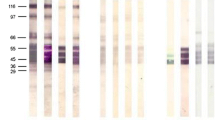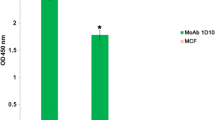Summary
Applying the indirect fluorescent antibody technique to the infective stages of the hookwormAncylostoma caninum, it appeared that they do not show IgG antibody binding when serum from dogs infected withA. caninum was used in the test (antiserum). However, inhibiting these stages metabolically with azide or with low temperatures, IgG antibody binding to the outer surface was observed. When the inhibitory factors were removed, shedding of fluorescent substances was seen, which were obviously coming from the outer surface of the larvae. This suggests that shedding of the antigen might occur.
Similar content being viewed by others
References
Anya, A.: Localization of ribonucleic acid in the cuticle of nematodes. Nature209, 827–828 (1966)
Barret, J.: Energy metabolism in nematodes. In: The organization of nematodes, Neil A. Croll, ed. London-New York: Academic Press 1976
Brand, T. von: Physiological observations upon a larval Eustrongylides. VIII. Influence of respiratory poisons upon the aerobic gaseous metabolism. J. Parasitol.31, 381–393 (1945)
Costello, L.C., Grollman, S.: Oxygen requirements ofStrongyloides papillosus infective larvae. Exp. Parasitol.7, 319–327 (1958)
Eckert, J.: Zur Physiologie invasionsfähiger Larven der Trichostrongylidae. Z. Parasitenkd.29, 209–241 (1967)
Fernando, M.A.: Metabolism of hookworms. I. Observations on the oxidative metabolism of free-living third stage larvae ofNecator americanus. Exp. Parasitol.13, 90–97 (1963)
Klaver-Wesseling, J.C.M., Vetter, J.C.M., Visser, W.K.: A comparative in vitro study of antibody binding to different stages of the hookwormAncylostoma caninum. Z. Parasitenkd.56, 147–157 (1978)
Lee, D.: The distribution of esterase enzymes inAscaris lumbricoides. Parasitology52, 241–260 (1962)
Vetter, J.C.M., Klaver-Wesseling, J.C.M.: Unimpaired infectivity ofAncylostoma ceylanicum after storage in liquid nitrogen for one year. J. Parasitol.63, 700 (1977)
Watson, B.: The fine structure of the body wall and growth of the cuticle in adultAscaris lumbricoides. Q. J. Microsc. Sci.106, 82–91 (1965)
Author information
Authors and Affiliations
Rights and permissions
About this article
Cite this article
Vetter, J.C.M., Klaver-Wesseling, J.C.M. IgG antibody binding to the outer surface of infective larvae ofAncylostoma caninum . Z. Parasitenkd. 58, 91–96 (1978). https://doi.org/10.1007/BF00930795
Received:
Issue Date:
DOI: https://doi.org/10.1007/BF00930795




